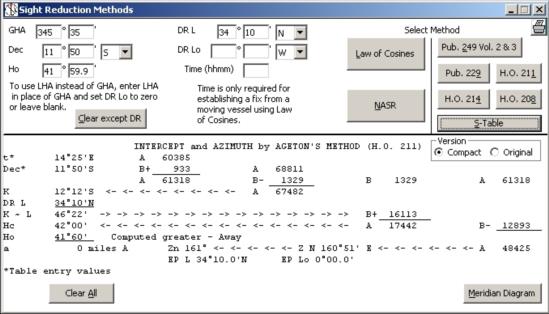
NavList:
A Community Devoted to the Preservation and Practice of Celestial Navigation and Other Methods of Traditional Wayfinding
Re: Ageton Classic Sight Reduction Table Prototype
From: Stan K
Date: 2015 Oct 25, 21:15 -0400
From: Stan K
Date: 2015 Oct 25, 21:15 -0400
Greg,
Ageton-Bayless method is exactly the same as the Ageton method, but the tables have been compacted by 1) "Entries for half-minutes of arc have been deleted..."; and 2) "The numerical duplication of the second half of Ageton's Table has been eliminated..." This results in a nine page table, rather than the 36 page table of the original H.O. 211 (which I thought was already pretty compact).
However, your method works differently than the Ageton (or Ageton-Bayless) that I am familiar with. Attached is a screen shot of the Celestial Tools "Ageton Compact" output using the input data from your example and the format right out of the book. Yours seems simpler, and does not involve a K value. Only one of the table values is the same in both methods. Apparently I do not yet understand how you are doing it, and my head already hurts, so please walk me through when you get a chance.
(BTW, I noticed that there are two different values of Hc on the index card.)
Stan

-----Original Message-----
From: Greg Rudzinski <NoReply_Rudzinski@navlist.net>
To: slk1000 <slk1000@aol.com>
Sent: Sun, Oct 25, 2015 7:39 pm
Subject: [NavList] Re: Ageton Classic Sight Reduction Table Prototype
From: Greg Rudzinski <NoReply_Rudzinski@navlist.net>
To: slk1000 <slk1000@aol.com>
Sent: Sun, Oct 25, 2015 7:39 pm
Subject: [NavList] Re: Ageton Classic Sight Reduction Table Prototype
Stan,
I haven't had the chance to do an Ageton Bayless reduction. I'm guessing that it is another variation of the split triangle formula. Ageton Classic uses the standard sin cos single triangle formula. The natural sin cos tables are needed to convert directly from a csc sec log value to a natural sin cos. This saves a table and a step.
Greg Rudzinski
From: Stan K
Date: 2015 Oct 25, 13:50 -0400Greg,How does this differ from the Ageton-Bayless compact version of H.O. 211? I see you have sin and cos values, but I'm not sure why. They are needed to create the A and B values, but are not used in the computation of intercept or azumuth. I also see the B value has tenths, where Ageton-Bayless rounds to whole numbers.Stan







